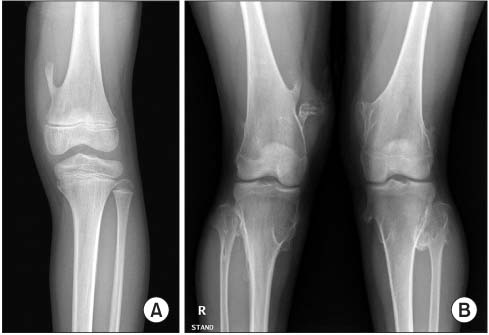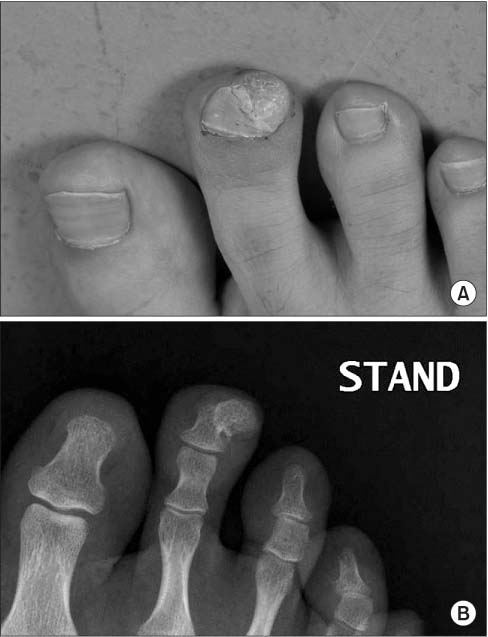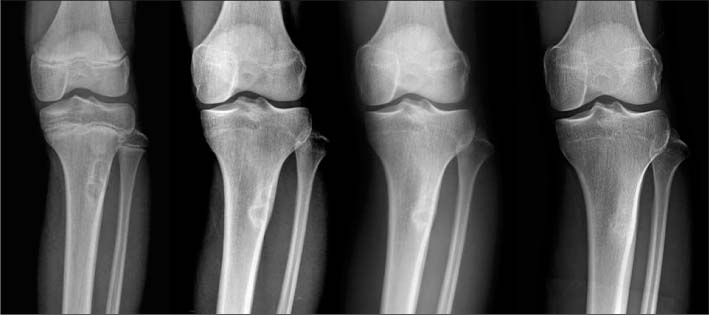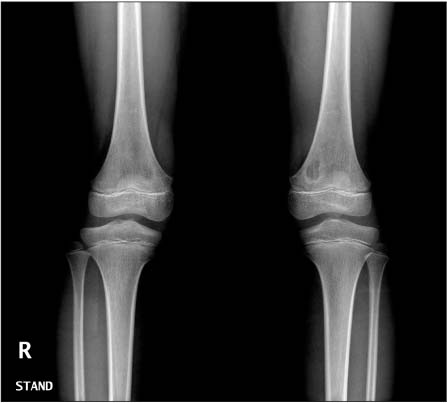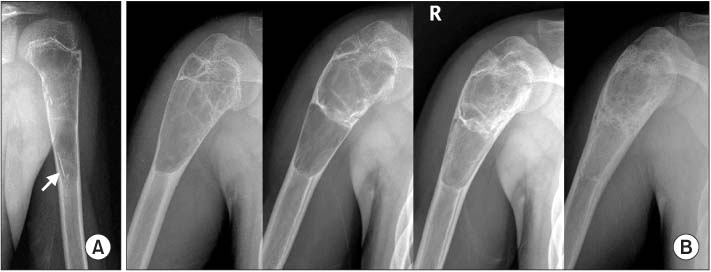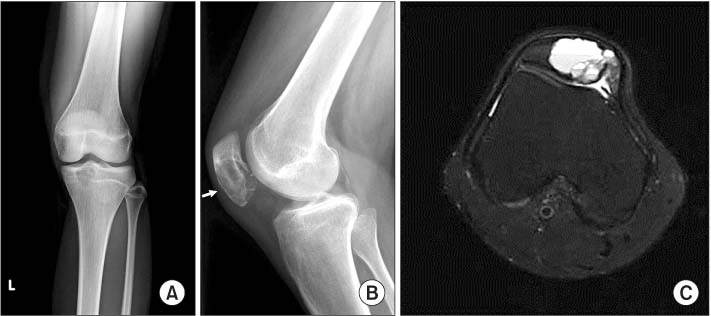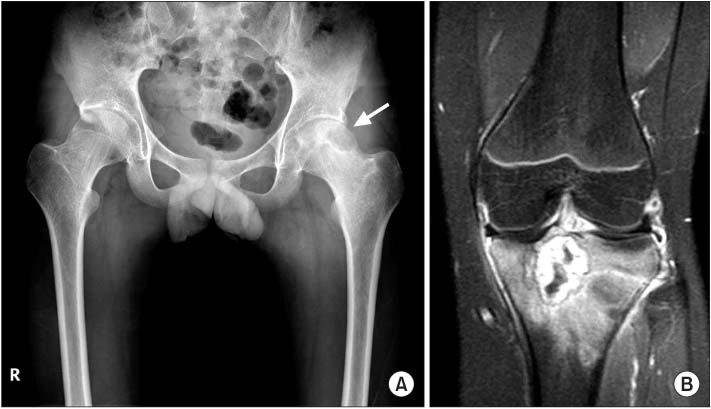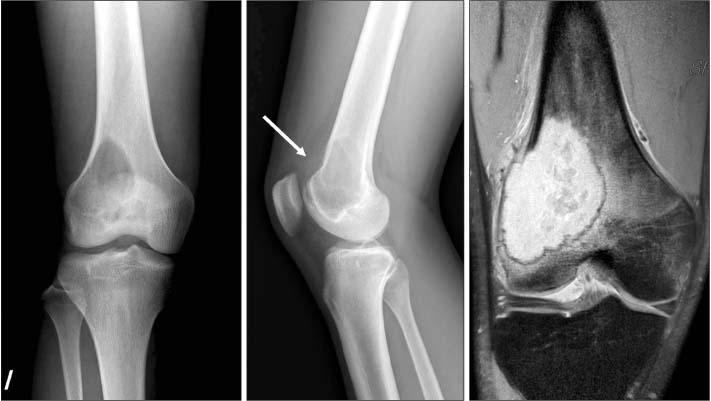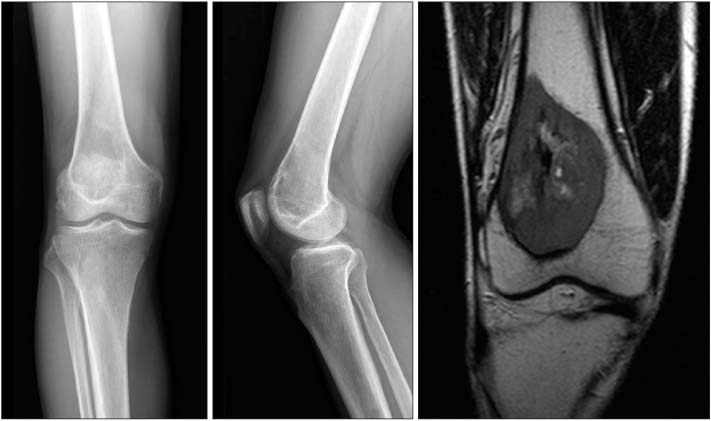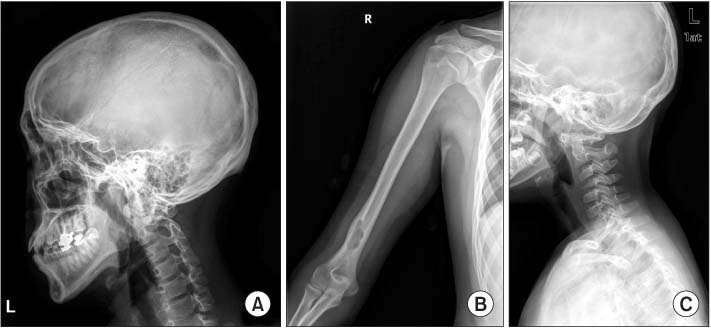J Korean Orthop Assoc.
2014 Dec;49(6):411-421. 10.4055/jkoa.2014.49.6.411.
Common Benign Bone Tumors in Clinic
- Affiliations
-
- 1Department of Orthopedic Surgery, Seoul National University College of Medicine, Seoul, Korea. mdchs111@snu.ac.kr
- KMID: 2185154
- DOI: http://doi.org/10.4055/jkoa.2014.49.6.411
Abstract
- Benign bone tumors can be found in the following clinical situations: 1) incidental findings on chest radiograph for health screening without symptoms or radiographs after traffic accident; 2) radiographs for other orthopedic problems, such as osteoarthritis; and 3) pain caused by the tumor. Knowledge of various diseases and their clinical characteristics is required for diagnosis of benign bone tumors. In addition, one should consider carefully whether or not the lesion has the characteristics of benign bone tumor or possibility of malignancy so that proper treatment can be decided. In case the diagnosis cannot be confirmed, even though benign bone tumor is suspected on radiography, follow-up radiographs should be taken to rule-out malignant bone tumors.
Keyword
MeSH Terms
Figure
Reference
-
1. Garrison RC, Unni KK, McLeod RA, Pritchard DJ, Dahlin DC. Chondrosarcoma arising in osteochondroma. Cancer. 1982; 49:1890–1897.
Article2. Ahmed AR, Tan TS, Unni KK, Collins MS, Wenger DE, Sim FH. Secondary chondrosarcoma in osteochondroma: report of 107 patients. Clin Orthop Relat Res. 2003; 411:193–206.
Article3. Murphey MD, Choi JJ, Kransdorf MJ, Flemming DJ, Gannon FH. Imaging of osteochondroma: variants and complications with radiologic-pathologic correlation. Radiographics. 2000; 20:1407–1434.
Article4. Eliezri YD, Taylor SC. Subungual osteochondroma. Diagnosis and management. J Dermatol Surg Oncol. 1992; 18:753–758.
Article5. Glockenberg A, Sobel E, Noël JF. Nonossifying fibroma. Four cases and review of the literature. J Am Podiatr Med Assoc. 1997; 87:66–69.
Article6. Sposto MR, Navarro CM, de Oliveira MR, Gabrielli MF, Ferreira BA. Albright's syndrome: review of the literature and case report. J Nihon Univ Sch Dent. 1994; 36:283–287.
Article7. Cohen J. Simple bone cysts. Studies of cyst fluid in six cases with a theory of pathogenesis. J Bone Joint Surg Am. 1960; 42:609–616.8. Struhl S, Edelson C, Pritzker H, Seimon LP, Dorfman HD. Solitary (unicameral) bone cyst. The fallen fragment sign revisited. Skeletal Radiol. 1989; 18:261–265.9. Baig R, Eady JL. Unicameral (simple) bone cysts. South Med J. 2006; 99:966–976.
Article10. Kransdorf MJ, Stull MA, Gilkey FW, Moser RP Jr. Osteoid osteoma. Radiographics. 1991; 11:671–696.
Article11. Feletar M, Hall S. Osteoid osteoma: a case for conservative management. Rheumatology (Oxford). 2002; 41:585–586.
Article12. Peyser A, Applbaum Y, Khoury A, Liebergall M, Atesok K. Osteoid osteoma: CT-guided radiofrequency ablation using a water-cooled probe. Ann Surg Oncol. 2007; 14:591–596.
Article13. Martel Villagrán J, Bueno Horcajadas A, Ortiz Cruz EJ. Percutaneous radiofrequency ablation of benign bone tumors: osteoid osteoma, osteoblastoma, and chondroblastoma. Radiologia. 2009; 51:549–558.14. Greenspan A, Steiner G, Knutzon R. Bone island (enostosis): clinical significance and radiologic and pathologic correlations. Skeletal Radiol. 1991; 20:85–90.
Article15. Kyriakos M, Land VJ, Penning HL, Parker SG. Metastatic chondroblastoma. Report of a fatal case with a review of the literature on atypical, aggressive, and malignant chondroblastoma. Cancer. 1985; 55:1770–1789.
Article16. Riddell RJ, Louis CJ, Bromberger NA. Pulmonary metastases from chondroblastoma of the tibia. Report of a case. J Bone Joint Surg Br. 1973; 55:848–853.17. Thomas DM, Skubitz KM. Giant cell tumour of bone. Curr Opin Oncol. 2009; 21:338–344.
Article18. Kirchen ME, Menendez LR, Lee JH, Marshall GJ. Methotrexate eluted from bone cement: effect on giant cell tumor of bone in vitro. Clin Orthop Relat Res. 1996; 328:294–303.19. Bini SA, Gill K, Johnston JO. Giant cell tumor of bone. Curettage and cement reconstruction. Clin Orthop Relat Res. 1995; 321:245–250.20. Chang SS, Suratwala SJ, Jung KM, et al. Bisphosphonates may reduce recurrence in giant cell tumor by inducing apoptosis. Clin Orthop Relat Res. 2004; 426:103–109.
Article21. Thomas DM. RANKL, denosumab, and giant cell tumor of bone. Curr Opin Oncol. 2012; 24:397–403.
Article22. Leikin SL. Immunobiology of histiocytosis-X. Hematol Oncol Clin North Am. 1987; 1:49–61.
Article23. Yasko AW, Fanning CV, Ayala AG, Carrasco CH, Murray JA. Percutaneous techniques for the diagnosis and treatment of localized Langerhans-cell histiocytosis (eosinophilic granuloma of bone). J Bone Joint Surg Am. 1998; 80:219–228.
Article

